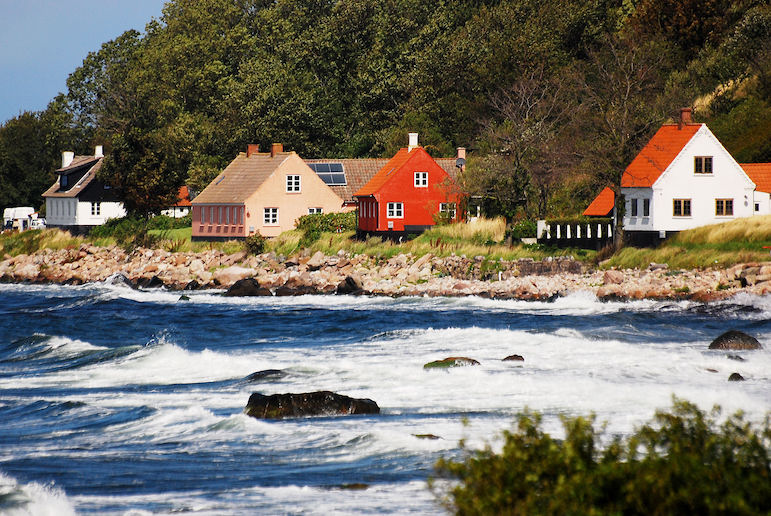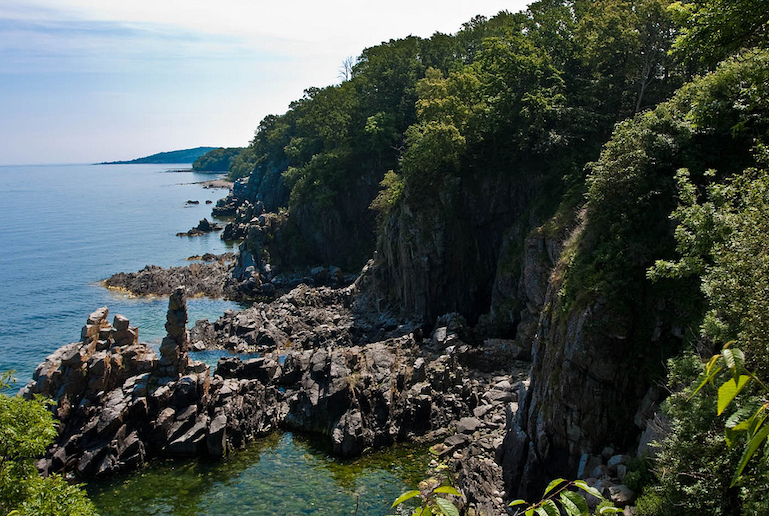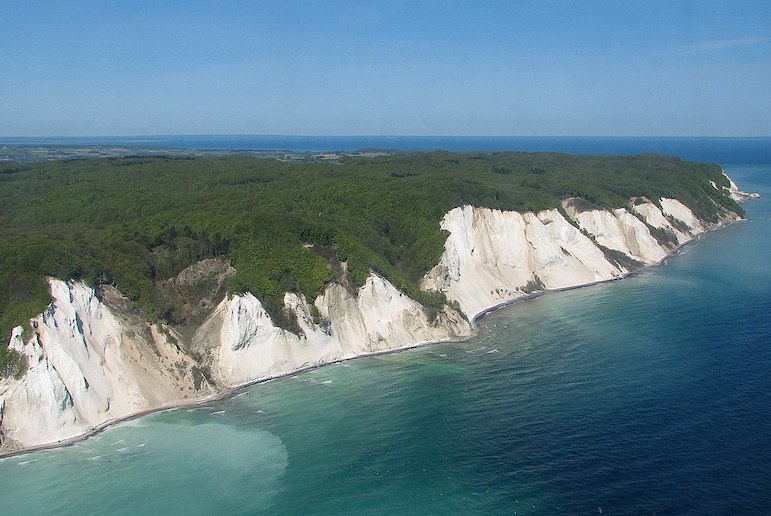You may be surprised to learn that Denmark has over 400 islands, more than 300 of which are uninhabited.

Of course, many of these islands are little more than small specks of sand, which can only be reached by kayak or boat, but others are huge, such as Zealand, home to the country’s capital Copenhagen.
Most visitors stick to the bigger islands of Funen, North Jutland and Zealand, but there are also some great small islands worth visiting.
Until the last century when Denmark embarked on several huge bridge-building projects, many of these islands were accessible only by boat.
And that means that they developed their own distinctive culture, local traditions, rich history and cuisine.
Today, some can still only be reached via a network of ferries, making the journey there part of the fun.
And we certainly think visiting an island or two is an essential part of any trip to Denmark. So we’ve picked our 6 favourite small islands where you can relax and enjoy the natural beauty and sense of tranquility.
Bornholm | Ærø | Samsø | Møn | Anholt | Vejrø
Bornholm
Although it belongs to Denmark, Bornholm is actually closer to Sweden and lies off Sweden’s southern coast.

Unlike most of Denmark, which is pretty flat, Bornholm has sea cliffs and rocky gorges making it a popular destination for climbers and hikers.
An 120km coast path runs around the entire island, or you can cut across the middle through one of Denmark’s largest forests on the 67km Højlyngsstien trail (Heather Path).
Bornholm is also home to Europe’s largest castle ruins, the medieval Hammershus fort, on the island’s rocky northern shore.
The ruins are free to wander around, but look particularly impressive from the sea, so we usually suggest taking this fun electric boat trip around the headland for great views of the castle.
Bornholm is also known for its four white round churches, dating from the 11th–12th century. Unusually they were built from granite in order to withstand pirate attacks – hence they are still standing today!
A great way to get round the island and to see the churches is to rent a bike. We like this bike tour app which guides you on a 50km circuit taking in the churches, Hammershus, sandy beaches, pretty fishing villages and harbours, giving you fun facts and interesting history on the way.
Bornholm has a string tradition of arts and crafts, including sculpture, ceramics, glass-blowing, jewellery making, textiles and wood-working. In fact, the island is Europe’s first ever UNESCO-designated World Craft Region.
Visit the Bornholm Art Museum to see work by local artists and learn about about the island’s artistic traditions.
Bornholm is a great place for foodies: there’s a Michelin-star restaurant, Kadeau, plus ten local smokehouses which sell cured and smoked herring.
Make sure you sample the island’s speciality sol over Gudhjem, a dish of smoked herring, raw egg and radish on rye bread.
Where to stay
There’s no shortage of places to stay on Bornholm whatever your budget. We like the Bådsted Camping close to the beach in Gudhjem, and the Hotel Blomme’s Place in the south of the island for those who prefer a little more luxury.
The rooms are stylishly decorated with their own terrace looking out onto a lovely garden, and there are free bikes for guests to use.
How to get there
It won’t surprise you learn that the quickest way to get to Bornholm is via Sweden.
Ferries take just 1 hour, 20 minutes to Rønne on Bornholm from the Swedish town of Ystad, which is just over an hour’s drive from Copenhagen via the Øresund bridge.
In summer, an overnight ferry runs from Køge, south of Copenhagen, leaving at 12.30am and arriving at 6am. And there’s also a ferry from Sassnitz on the German island of Rügen, which takes 3 hours, 30 minutes.
All the ferries are run by the Danish ferry company Bornholmslinjen.
Ærø
In the South Funen Archipelago, Ærø (or Aero) is a pretty island with lush green fields, sandy beaches, colourful beach huts and a laid-back vibe.

Our favourite thing to do here is to wander around the cobbled streets lined with colourful townhouses in its well-preserved 18th-century capital Eroskobing.
We also like the Marstal Maritime Museum, home to 300 model ships and a wealth of facts and info about the island’s sea-faring history.
The Aero Jazz Festival in early August is the island’s highlight, though there’s plenty to enjoy at other times of the year too.
Ærø has its own whisky distillery, brewery and even a cigar factory, where cigars are made from tobacco grown on the island.
And one more thing we thing about Ærø is that all its buses are free, so you don’t have to a bring a car over on the ferry!
For more on ideas on what to do in Ærø, read this guide to spending a budget-friendly weekend in Ærø.
Where to stay
Our top choice is the Aroma Guesthouse, right in the heart of Ærøskøbing, close to the harbour and with a private roof terrace.
How to get there
There are three ferry routes to Ærø: Svendborg to Ærøskøbing; and Faaborg and Fynshavn to Søby, in the north of the island.
There are 3–5 crossings a day from both Faaborg and Fynshavn to Søby, with both journeys taking around an hour.
About 10–12 ferries a day make the 75 minute trip from Svendborg to Ærøskøbing.
If you’re coming from from Copenhagen, it’s about a 2 hour, 30 minute drive to both Faaborg and Svendborg. The Fynshavn crossing is only really of use if you’re coming from the Jutland peninsula or Germany.
Samsø
The tiny island of Samsø lies in the Kattegut, west of Jutland, north of Funen and east of Zealand, pretty much in the middle of Denmark.

It has been populated since Vikings times, when its central location meant that it became a popular meeting point for local Viking clans and tribes. Today, however, it’s better known as the world’s first island to run entirely on renewable energy.
In fact, its wind turbines, solar panels and biomass-fuelled heating plants now produce so much electricity that some is exported back to the mainland each year.
Samsø is known throughout Denmark for its potatoes – there’s even a potato festival and an annual potato sandwich competition – but the island also prides itself on its other home-grown produce, including strawberries and other fruit and vegetables.
The island’s other attractions include the world’s largest maze, the Samsø Labyrinten, the Vesborg Lighthouse on the island’s southwest tip.
Where to stay
Its environmental credentials and home-grown produce make Samsø a popular destination for eco-tourists, who can stay in properties such as this grass-roofed wooden cabin surrounded by trees.
But our top choice is the apartments attached to the Vesborg Lighthouse, which have fantastic sea views and direct access to the beach.
How to get there
Ferries run from Aarhus and Hou on Jutland to Sælvig on Samsø’s east coast (both take an hour) and from Kalundborg on Zealand to Ballen on Samsø’s west coast (75–90 minutes).
From Copenhagen, it’s a 90-minute drive to Kalundborg, so we recommend taking the Kalundborg ferry.
Møn
The island of Møn lies just off the southeast coast of Zealand, almost directly south of Copenhagen.
It’s unusual in that its home to a 6km stretch of towering white chalk and limestone cliffs, which are protected as a UNESCO Biosphere Reserve.

Dating back around 70 million years, the Møns Klint chalk cliffs are one of Denmark’s highest points and are backed by forest and surrounded by a national park.
You can hike here, go mountain-biking, hunt for fossils on the beach, take a boat trip along the coast to see the cliffs from below, or look out over the treetops from the forest tower.
If you want to explore Møns Klint without any hassle, we like this full-day minibus tour that takes you directly there from Copenhagen with a knowledgable guide to explain the history and geology.
Møn’s dramatic attractions include the romantic 18th-century Liselund Palace and gardens and and the striking frescos in Møn’s oldest church, the 11th-century Elmelunde Church.
Where to stay
We like the smart apartments overlooking a lake at Villa Huno. In the Biosphere Reserve and surrounded by woods, the villa is within walking distance of Møns Klint and has camping and glamping pitches too.
How to get there
There are no ferries to Møn, but two bridges connect the island to Zealand.
The most direct route to Møn from Copenhagen takes about an hour and 40 minutes to drive, via the E20 and the E47 south towards Nyråd, then route 50 onto the island.
Anholt
The tiny island of Anholt (just 22 square kilometres) lies in a remote location in the Kattegat sea half-way between Denmark and Sweden.

Fringed by sandy beaches, it’s home to northern Europe’s largest low heath, a unique desert-like environment known as Ørkenen (“the desert”) that’s a haven for wildflowers and birdlife.
Pretty much the island’s only sight is the Anholt lighthouse, one of Denmark’s oldest dating back to 1560, and a nearby colony of spotted seals.
The seals breed here so there’s no public access, but you can watch them through binoculars from a small observation hut near the lighthouse.
Known for its tranquil vibe and dark skies, there’s little to do on Anholt except walk, rent bikes, sail, go paddle-boarding or just chill out and enjoy the peace and quiet.
Where to stay
Most of the accommodation on Anholt consists of low-key cabins and holiday homes, such as this cosy cabin close to the coast.
Or, there’s the friendly Casablanca Hostel, with cheap and cheerful bunk-beds and family rooms, some with sea views, right by the ferry harbour.
How to get there
The only way to get to Anholt, other than with your own boat, is on the Grenaa to Anholt ferry, which leaves daily from Grenna at noon–1pm and arrives in Anholt about three hours later.
The return ferry leaves Anholt at 8–9am. On some summer weekends there are two sailings a day. It’s a four-hour drive from Copenhagen to Grenaa.
Vejrø
In the Smålandsfarvandet Sea, off the coast of Lolland, the car-free island of Vejrø lies between the islands of Lolland, Zealand and Langeland.

One of Denmark’s smallest islands, it covers an area of just 1.57 square kilometres, and its unspoiled natural beauty and tranquility make it a haven for peace-seekers.
The island is privately owned with just four permanent residents, and its owners are committed to running it as sustainably as possible.
Vejrø is largely self-sufficient with solar panels and wind turbines providing renewable energy, while the upmarket restaurant Skipperly serves seasonal organic food grown in greenhouses and around the island.
The open landscapes and quiet beaches are a haven for local birdlife, with a rich variety of species making it a great spot for bird-watching.
Cattle, pigs, sheep goats and chickens graze in the fields, while pheasants and deer roam freely.
Vejrø Lighthouse, the marina and café are in the north, but you can easily walk around the whole island – or rent bikes or take the electric buggy provided by the hotel.
Where to stay
All accommodation on the island is run by the Vejrø Resort, which has high-end, eco-friendly apartments, the smart Blæsenborg Hotel in a converted farmhouse, plus a variety of houses and cottages around the island to rent.
How to get there
If you stay at the Vejrø Resort, the resort’s private ferry service from Kragenaes on Lolland to Vejrø (30 minutes) is included in the price.
There’s also a small airstrip on the island, and the resort can organise small aircraft or helicopter flights. Alternatively, you can sail there yourself and moor at the marina.
Tips for visiting Denmark’s small islands
- Summer is the peak time to explore Denmark’s islands, when the days are long and weather is mild. But we suggest going in autumn, when the crowds have left, the trees are beautiful colours and you can wrap up warm in front of a campfire after a long blowy walk.
- Local transport varies from island to island. We like the car-free Vejrø, where you can cycle or walk, and Aero, where all local buses are free.
- Bring clothes for all weathers. Even in summer, some islands can be windy and wet, so make sure you bring waterproofs as well as sunscreen.
- Bring supplies with you. If you’re self-catering it’s worth bringing basics with you from the mainland. Since most groceries have to be imported onto the islands, they usually cost more.
Small Danish islands compared
| Island | Total Area (sq km) | Total Population | Nearest Big City |
|---|---|---|---|
| Bornholm | 588.36 | 39,695 | Ystad, Sweden |
| Aero | 88 | 6,000 | Svendborg |
| Samsø | 114 | 3,720 | Aarhus |
| Møn | 218 | 10,500 | Nykøbing Falster |
| Anholt | 22.4 | 150 | Aarhus |
| Vejrø | 1.57 | 4 (Vejrø Resort staff) | Nykøbing Falster |

